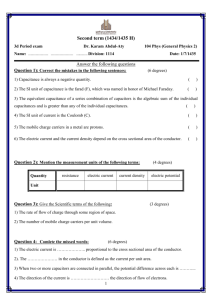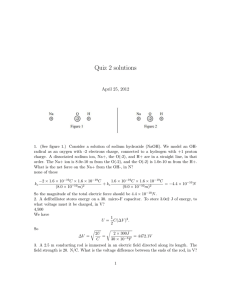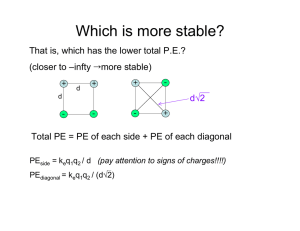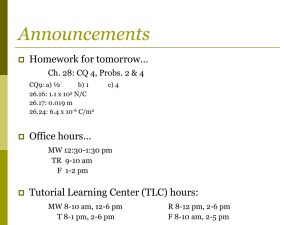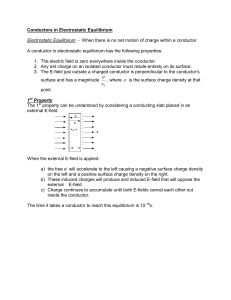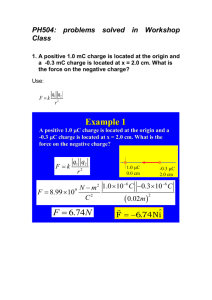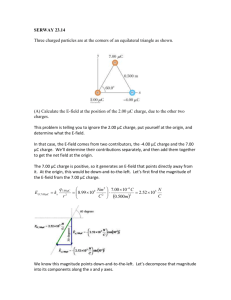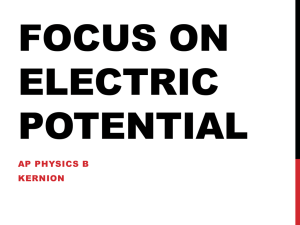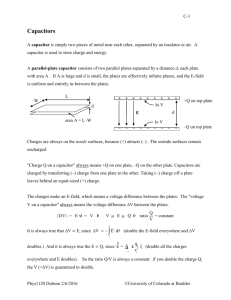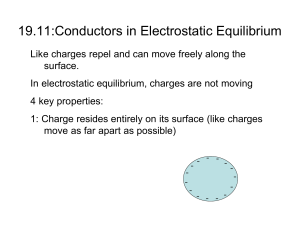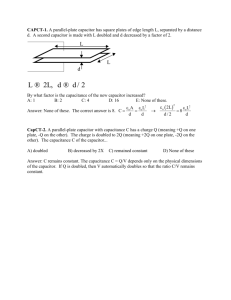chapter29.3 - Colorado Mesa University
advertisement
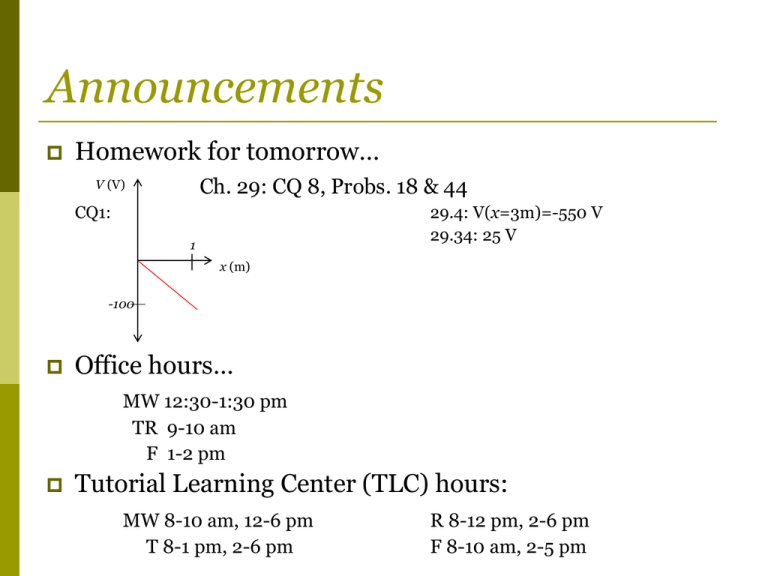
Announcements Homework for tomorrow… Ch. 29: CQ 8, Probs. 18 & 44 V (V) CQ1: 29.4: V(x=3m)=-550 V 29.34: 25 V 1 x (m) -100 Office hours… MW 12:30-1:30 pm TR 9-10 am F 1-2 pm Tutorial Learning Center (TLC) hours: MW 8-10 am, 12-6 pm T 8-1 pm, 2-6 pm R 8-12 pm, 2-6 pm F 8-10 am, 2-5 pm Chapter 29 Potential & Field (A Conductor in Electrostatic Equilibrium & Capacitance and Capacitors) Review… Electric potential difference from the Electric field… ΔV = negative of the area under the E vs. s curve between si & sf The emf of the battery is the work done per charge… (ideal battery) Electric field from potential difference.. component of E-field in the s direction! Quiz Question 1 An electron is released from rest at x 2 m in the potential shown. What does the electron do right after being released? 1. Stay at x 2 m. 2. Move to the right at steady speed. 3. Move to the right with increasing speed. 4. Move to the left at steady speed. 5. Move to the left with increasing speed. i.e. 29.5: Finding the E-field from the equipotential surfaces Estimate the strength and direction of the E-field at pts. 1, 2, & 3. i.e. 29.5: Finding the E-field from the equipotential surfaces Estimate the strength and direction of the E-field at pts. 1, 2, & 3. Kirchoff’s Loop Rule… The sum of all the potential differences encountered while moving around a closed path is zero. 29.4: A Conductor in Electrostatic Equilibrium E-field is ZERO inside a conductor in electrostatic equilibrium. Any two points within the conductor are at the same electric potential. Entire conductor is at the same electric potential. The exterior E-field of a charged conductor is perpendicular to the surface. The exterior E-field (& surface charge density) is largest at sharp points. 29.4: A Conductor in Electrostatic Equilibrium Close to the surface, the E-field is still nearly perpendicular to the surface. Equipotential surface close to an electrode must roughly match the shape of the electrode. 29.5: Capacitance and Capacitors How does a capacitor get charged? Capacitor plates are connected to the two terminals of a battery via conducting wires. Once connected, what happens? How does ΔVC compare to ΔVbat? 29.5: Capacitance and Capacitors Any two points in a conductor in electrostatic equilibrium are at the same potential. Quiz Question 2 Three charged metal spheres of different radii are connected by a thin metal wire. The potential and electric field at the surface of each sphere are V and E. Which of the following is true? 1. V1 = V2 = V3 and E1 = E2 = E3 2. V1 > V2 > V3 and E1 = E2 = E3 3. V1 < V2 < V3 and E1 = E2 = E3 4. V1 = V2 = V3 and E1 > E2 > E3 5. V1 > V2 > V3 and E1 > E2 > E3 6. V1 < V2 < V3 and E1 < E2 < E3 Capacitance and Capacitors How is the charge on capacitor plates, Q, related to the potential difference between the plates, ΔVC? Capacitance and Capacitors How is the charge on capacitor plates, Q, related to the potential difference between the plates, ΔVC? - Capacitance Notice: Capacitance is a purely geometric property of the electrodes SI Units: farad

